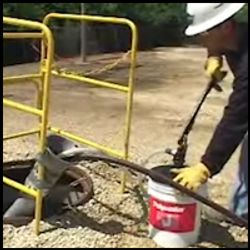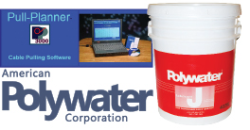- Cyclone Alfred
15 Apr, 2025 - TEN unveils our new brand identity
11 Apr, 2025 - Compression Fitting Failures
14 Mar, 2025 - Understanding How Conduit Sealants Perform in the Presence of Fire
6 Feb, 2025 - Employee of the Year 2024
15 Jan, 2025 - National Work Safety Month 2024
9 Dec, 2024 - Wildlife Mitigation Products
21 Oct, 2024 - Lou's 25th Anniversary
14 Oct, 2024 - TEN HQ is moving
2 Sep, 2024 - Highlights from TENNET 2024
1 Jul, 2024 - The Zero Splice Rule
28 Jun, 2024 - ALE - ClampStar Conductor Repair
31 May, 2024
Coefficient of Friction25 Sep, 2015 Estimating Tension when pulling cable into conduitWhen you calculate cable pulling tensions, what friction coefficient should you use? User responses vary . . . some answer “0.5” . . . others “0.4,” or “0.35”. Who’s right?? What coefficient of friction provides the best tension estimates and correlation for field planning and optimal cable system design? To answer this question, we need to understand more about “coefficient of friction.” What exactly is a “coefficient of friction” (COF)?Let’s start with a simple physics class example . . . a wooden block (say, 5 kgs in weight) on a horizontal steel plate. Say it takes 2 kgs force (19.6N) to pull (drag) the block across the plate. The coefficient of friction (wood on steel) is defined as the ratio of this “dragging force” (2 kgs) to the normal force (weight of 5 kg). In this case, the friction coefficient would be .4. Note that the COF is a dimensionless number. Experience tells us that if we replace the wooden block with a 5 kg rubber block, it will take a greater force to drag the rubber block (say, 6 kgs force). The measured coefficient of friction (rubber/steel) would be 1.2. What’s important to note from these examples is that there is no single coefficient of friction. The friction coefficient varies with the rubbing surfaces. Cable/Conduit Even with these differences, the friction coefficient in cable pulling continues to depend on cable jacket type, conduit type and lubricant type. “General” coefficients don’t mean much. The most accurate tension estimates come from friction coefficients specific to the cable, conduit and pulling lubricant. Pulling Equations Straight Conduit Tout = Tin + LWµ Conduit Bend Tout = Tin eµθ Where: Tout = Tension Out Note the significant effect on tension that small changes in µ (friction coefficient) can cause, especially in conduit bends where this friction coefficient is in the exponent. Inaccurate friction coefficients lead to poor correlation of tension calculations with actual tensions. Unfortunately, it is in multi-bend pulls, where the tension and sidewall pressure are of most concern, that the use of an inaccurate coefficient of friction produces the greatest error. Where can you find or how can you determine meaningful friction coefficients? EPRI Study Helpful The EPRI research showed that lubricated coefficient of friction changes with varying normal force (the force pushing the cable against the conduit wall). The EPRI report defines two different friction coefficients, one at “high sidewall bearing pressure” (High SBP) (going around bends) and the other at “low sidewall bearing pressure” (Low SBP) (straight pulls). Surprisingly, the High SBP friction coefficient is usually lower The EPRI report goes on to recommend that the High SBP friction coefficient be used in calculations when normal force on the cable is over 220kg/m (150 lbs/ft), and that otherwise the Low SBP coefficient of friction be used. Polywater Research Clarifying In contrast to the EPRI work, however, our research indicates the conversion in friction to the High SBP type occurs continuously and at bearing pressures much less than 220kg/m (150 lbs/ft). Pulling Tests The graph below shows measured friction coefficients plotted against the tension on the cable as it enters the conduit helix. For this graph, the conduit was high density polyethlene with 540° of bend. The cable had a polyethylene jacket. To explain the graph, first you must know that Polywater J and Polywater F are two of American Polywater’s high-performance cable pulling lubricants (“J” is usually used for electrical cable and “F” for fiber optic cable). They are similar chemically, except that “J” is a gel lubricant (higher viscosity) and “F” is a liquid. Where the lines converge on the graph, and the slope levels, the low bearing pressure friction has disappeared and the cable and lubricant are in a high bearing pressure mode. By calculating the sidewall-bearing pressures (defined as tension out of the bend divided by bend radius) at the point of Because power cable’s stiffness and resulting “spring” tend to increase conduit contact pressure, power cable pulling ends up in the “high bearing pressure” mode most of the time. Field-measured tensions tend to support this conclusion. On the other hand, lighter, flexible cables (fiber optic, etc.) often demonstrate both types of friction during pulling. This is one reason why a lower viscosity, liquid lubricant like Polywater F is best for the installation of this type of cable. Pull-Planner™ 2000 Has Friction Data Base American Polywater’s laboratory has developed extensive friction data for different cable jacket and conduit types, at appropriate bearing pressures. This data is in an internal data base in our PullPlanner™ 2000 for Windows™ Software. The Pull-Planner™ 2000 provides a convenient way to calculate cable pulling tensions on a PC. It enables “what if” scenarios with cable, conduit, pull length, COF, incoming tension, and more. Lubricant quantities can be calculated, and Pull-PlannerTM 2000 Preview |



|


